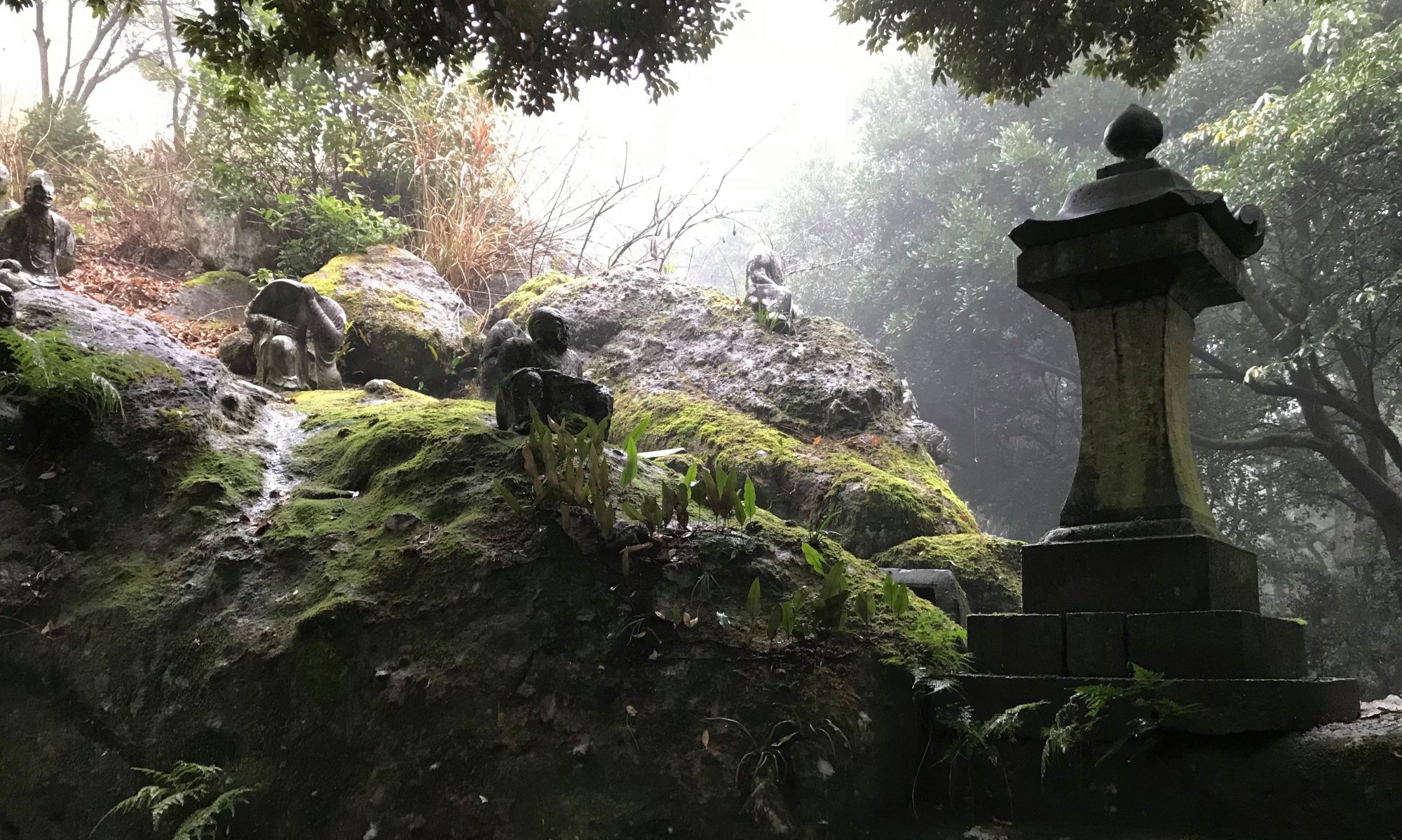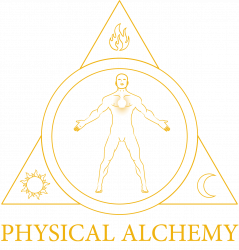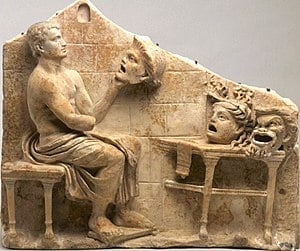A while back I had the pleasure of attending an art exhibition held here in Canberra entitled ‘Ancient Greeks: athletes, warriors and heroes’.
The title was partially deceptive, in that a lot of the exhibition – by proxy of the artifacts – exhibited the craft traditions of the ancients, too. Poetry, music and dance we clearly featured. Moreover there was a coherence present in the artifacts as a whole. A snapshot of a civilization where there was clear and coherent interface and interaction between athletics, crafts, philosophy, mysticism, music, dance, poetry and acting.
A culture where people of these persuasions knew each other and interacted regularly. It was known: these are all facets of human civilization with merit.
One statue that particularly drew my attention was beautiful column of the Muses. The Muses are [*cough* *cough*] 9 in number. And, though I have seen their spheres of influence translated differently, their domains [as fields of inquiry and inspiration] would make an extremely interesting base for an educational system [even in this age]. A pity, we no longer value these so highly.
Next to the muses was a bust of Aristophanes [Ἀριστοφάνης] – the great poet and playwright. By the birds, his work appeared to me [manner syncronistika maximus], not so long ago. His play ‘the Clouds’ is even singled out by Plato as involved in leading to the trial of Socrates*.
Reading the synopsis of Aristophane’s play ‘the Clouds’ was a time recently that I had a fit of full body laughter [not a domesticated chortle].
For people who don’t know, the basic plot outline [*spoilers ahead*]:
Revolves around Strepsiades, a father trying to clear debts incurred by his sons gambling habit.
He wakes with the epiphany that if he – or moreover, his son – can learn to argue well in court, he will be cleared of his debt via powers of argumentation alone.
He tries to persuade his son to join ‘The Thinkery’ [‘a school for wastrels and bums that no self-respecting, athletic young man dares to be associated with’**].
The title was partially deceptive, in that a lot of the exhibition – by proxy of the artifacts – exhibited the craft traditions of the ancients, too. Poetry, music and dance we clearly featured. Moreover there was a coherence present in the artifacts as a whole. A snapshot of a civilization where there was clear and coherent interface and interaction between athletics, crafts, philosophy, mysticism, music, dance, poetry and acting.
A culture where people of these persuasions knew each other and interacted regularly. It was known: these are all facets of human civilization with merit.
One statue that particularly drew my attention was beautiful column of the Muses. The Muses are [*cough* *cough*] 9 in number. And, though I have seen their spheres of influence translated differently, their domains [as fields of inquiry and inspiration] would make an extremely interesting base for an educational system [even in this age]. A pity, we no longer value these so highly.
Next to the muses was a bust of Aristophanes [Ἀριστοφάνης] – the great poet and playwright. By the birds, his work appeared to me [manner syncronistika maximus], not so long ago. His play ‘the Clouds’ is even singled out by Plato as involved in leading to the trial of Socrates*.
Reading the synopsis of Aristophane’s play ‘the Clouds’ was a time recently that I had a fit of full body laughter [not a domesticated chortle].
For people who don’t know, the basic plot outline [*spoilers ahead*]:
Revolves around Strepsiades, a father trying to clear debts incurred by his sons gambling habit.
He wakes with the epiphany that if he – or moreover, his son – can learn to argue well in court, he will be cleared of his debt via powers of argumentation alone.
He tries to persuade his son to join ‘The Thinkery’ [‘a school for wastrels and bums that no self-respecting, athletic young man dares to be associated with’**].
His son refuses.
So he decides to enroll himself.
The headmaster of the school is none other than Socrates himself.!
After initial enthusiasm, Socrates quickly becomes infuriated with his matured aged students’ inability to grasp the lessons.
He proscribes a laying incubatory-style praxis to help inculcated the capacity for higher thought.
He returns to find Strepsiades masturbating instead of using the practices to refine his thinking.
This most displeases Socrates and Strepsiades is expelled.
His son is finally convinced to enroll and undergoes an inauspicious transformation from athletic youth to cold and calculating nerd. The plan backfires as the son begins to argue with the father, instead of helping him argue his way to a clean slate. Strepsiades is enraged and chases awaym with pitchfork and torch, the students of the Thinkery.
So he decides to enroll himself.
The headmaster of the school is none other than Socrates himself.!
After initial enthusiasm, Socrates quickly becomes infuriated with his matured aged students’ inability to grasp the lessons.
He proscribes a laying incubatory-style praxis to help inculcated the capacity for higher thought.
He returns to find Strepsiades masturbating instead of using the practices to refine his thinking.
This most displeases Socrates and Strepsiades is expelled.
His son is finally convinced to enroll and undergoes an inauspicious transformation from athletic youth to cold and calculating nerd. The plan backfires as the son begins to argue with the father, instead of helping him argue his way to a clean slate. Strepsiades is enraged and chases awaym with pitchfork and torch, the students of the Thinkery.
It is art.
It was written in ~400BC – and yet is so humorously contemporary.
I had been, just prior to having this play fall into my lap, performing the heinous duty of tracking how metamoderism is interfacing and interfering with the training of the physical body.
One could straight lift many of the plays themes into the physical work sphere: ‘Thinkery’ becomes ‘meta-thinkery’ or, more aptly, the ‘metathinkamovery’. The part in the play where Aristophanes lampoons the Thinkery’s latest inventions could easily translate into any humdrum movement or neuroneuro screening protocol; or fascinating with all things haptics, ‘movement philosophy’ or embodied cognition.
The play translates across some 2400 years because the disenchantment functions the same across time [i.e. is not a byproduct of modernity or the scientific revolution; though these are involved in how it manifests in this era].
Back to the body.
Few people in contemporary society can laugh fully or do so regularly.
Mirth is arrested.
Chortling, permissible.
Wry smile and mechanical haughty false laughter,
encouraged.
Full body laughter is offensive.
It is an affront to aspects of the undertow.
It has too much life.
Very often, too, it comes about from someone pointing out a taboo that the civilization-coding cannot handle.
You can mock edifices that are in stasis
but ‘a rolling stone gathers no moss’.
In part, living [sub]cultures are resistant to mockery for this very reason.
Whereas the dead ones are sitting ducks.
The capacity of expressing laughter fully in the body is different than its capacity to move; its suppleness or flexibility. Working on these can help free the laugh trapped in the flesh statue
but they are not the same qualities.
It goes the other way, too.
More interestingly so
in fact.
The act of allowing fuller and fuller mirth ‘wrung out’ some very interesting structures for me. Aspects of the tendon of diaphragm and renal fascia were *worked* in a way I have never experienced. Similarly the act of weeping fuller allowed me to work the structure of my ribcage and upper thoracic in ways even the deepest rotations and Human Crossbow stretch never did [and I am right up there in the top handfuls of people I have met in terms of my ability to use these postures to work the body].
Of course, there are atmospherics and other correlations to all this.
Most comedies aren’t.
Breaking through peoples dense patterning to allow true laughter to occur is a difficult thing to do. To face our inability to laugh fully is to face the extent of our inhumanity.
We talk all about assessing peoples motions, movements and abilities – but does anyone take working with ’embodied mirth’ seriously [?!]
They do.
And it’s me! 😀
And it will be the topic of one of some upcoming notes articles, here on the site. I found out a number of very cool and little known things about the body and mirth whilst in interplay with a number my colleagues.
[D]
* watch the *step* [ ]
]
** from [https://en.wikipedia.org/wiki/The_Clouds#Plot]
** from [https://en.wikipedia.org/wiki/The_Clouds#Plot]


